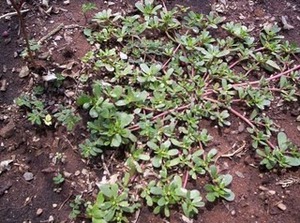Ideas for eating verdolagas (aka purslane)

Verdolagas is purslane, and it is in your garden
Photo | Martha Bayer
On the annarborfood email list, a recent topic of discussion has been purslane, an easily recognizable weed that most of us have pulled from our gardens by the bushel. The fleshy green teardrop shaped leaves of purslane are attached to reddish stems, and taste a little tart and salty, but very mild.
Some sources say purslane was introduced in North America by the Vikings, some say it came from South America, some say it is native to India. Talking to my mom the other day, I learned that my great-grandmother called it by an older name — "pusley."
Before Great Grandma Callihan's day, purslane was grown purposely in gardens, and now it has been "re-discovered" for its nutritional, culinary and economic(!) qualities. People are excited about purslane because it is: cheap (actually, free — find it growing next to the sidewalk) and also an extremely good source of omega-3 fatty acids (which you usually have to eat fish oils or flaxseed to get) and vitamins A and C. It's also kind of tasty.
My friend, Martha, says that in Mexico purslane, sold in grocery stores and at farmers markets, is called "verdolagas." I'm pretty sure that while I would not eat something that sounds as awful as "pusley," I would definitely want some "verdolagas" on my plate.
Luckily, my grandmother recently sent me an article from the Arizona Daily Star that had some ideas about how to cook verdolagas.
"Known as Mexican watercress or purslane to its fans, and viewed as a weed by its detractors, the green leafy verdolagas have reddish stems and small yellow flowers. 'We love to fry them up with onions and chiles, mix them with beans and sprinkle Mexican cheese on top,' said Ramiro Romero, a native Tucsonan. 'Then we eat them with warm corn tortillas.'"
Other suggestions include: sauteeing them with tomatoes and garlic; cooking them "Sonora -style" with onions and a bit of milk mixed with flour to make a gravy; or scrambling them together with eggs. I heard recently that a farm dinner at Tantre included a purslane potato salad. Even Epicurious has a number of purslane recipes.
But what I'd really like to make is one of Martha's recipes. She wrote me yesterday saying "I am also growing verdolagas in my garden and, in fact, today I will cook some. There are many recipes that use this weed and are very yummy but my mom always cooked them in a green or red sauce with beef or pork." Martha recommends Verdolagas en Salsa Verde, but her own recipe is this one:
Verdolagas con Espinazo, aka, Purslane with Backbone Stew
- 3 pounds beef or pork backbone
- 1 1/2 medium onion
- 5 cloves of garlic
- 3 red dried California chiles
- 1 pound tomatillo (about 6 medium)
- 4 bunches of fresh purslane, cleaned (from your garden or buy at the farmers' market)
- salt and pepper to taste
In a large pot, add backbone and cover with water. Add 1 onion cut in half and 3 cloves of garlic. Add salt to taste and cook at low heat for 1-2 hours or until the meat is tender.
In a medium pot, add the red chiles, 2 cloves of garlic, tomatillo, and half of onion. Cover with water and cook for 15 minutes. When cooked, process in a blender with salt and pepper to taste. Put the sauce through a strainer to separate the solids. Reserve.
When the meat is cooked, add the sauce to the stew and let it come to boil for 5 more minutes. If needed, add more salt and pepper. Add purslane, turn the stove off and cover. Purslane will cook with the heat of the stew and would be ready to serve in 3 minute. Serve hot accompanied with beans and corn tortillas.
Kim Bayer is a freelance writer and culinary researcher. Email her at kimbayer@gmail.com.

